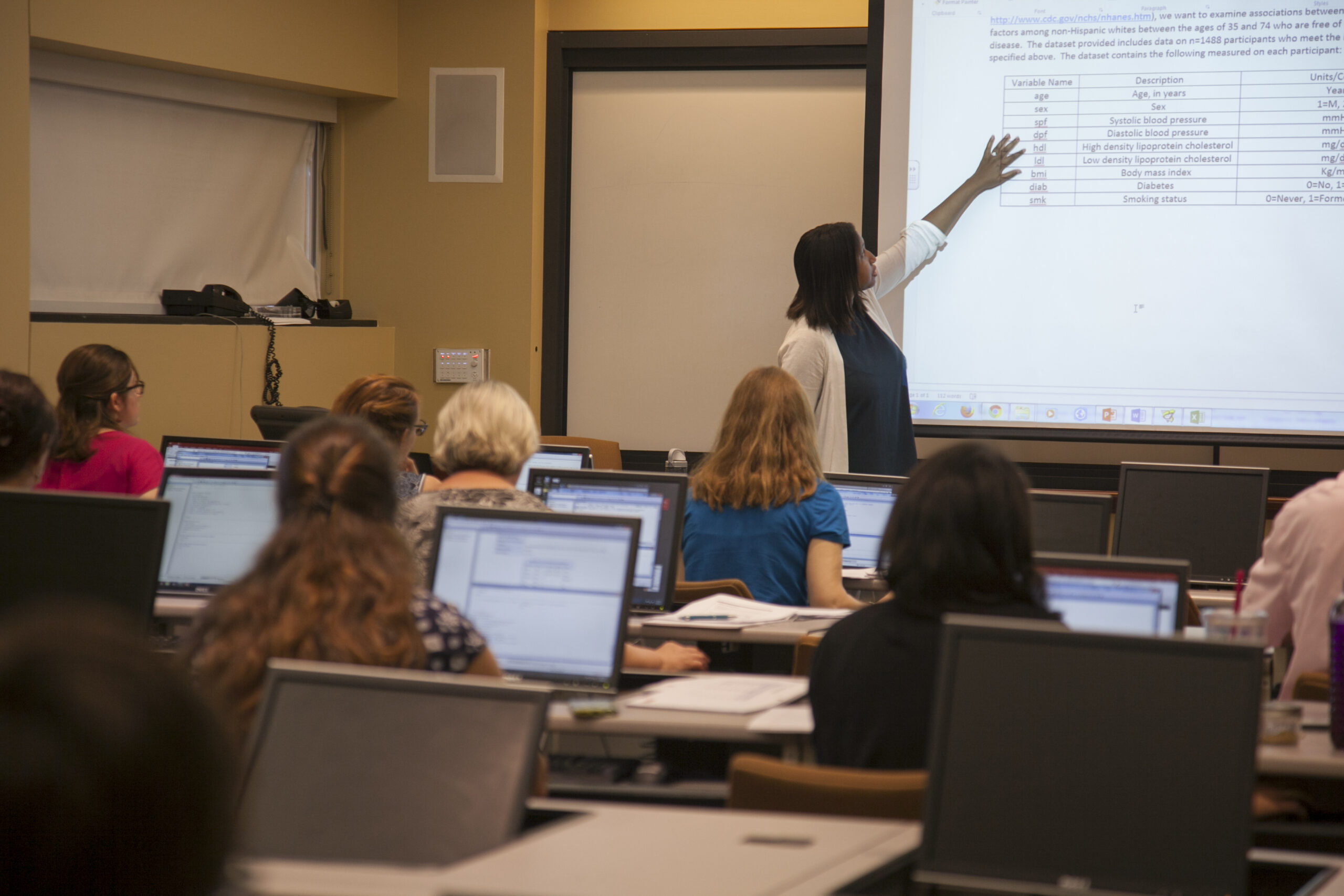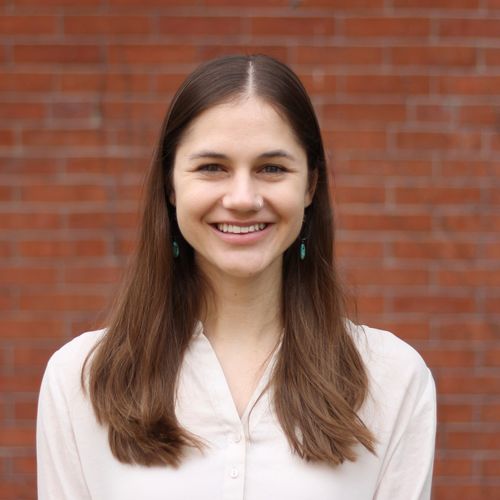What Constitutes the “Core” of Public Health?
Current and past on-campus MPH core course instructors weigh in on the importance of the core curriculum for the next generation of capable and caring public health professionals.

What Constitutes the “Core” of Public Health?
Current and past on-campus MPH core course instructors weigh in on the importance of the core curriculum in producing the next generation of capable and caring public health professionals.
Jacqueline Hicks, a clinical associate professor of biostatistics and a core course instructor, teaches a classroom of students. Photo credit: Nick Gooler
The core curriculum is a rite of passage for students in the on-campus Master of Public Health program at the School of Public Health.
Since 2016, each student enrolled in the program has started their graduate education with the same four courses designed to provide them the groundwork from which to launch transformative public health careers, regardless of their backgrounds.
“The goal of the core curriculum is to give students the foundational knowledge and skills needed to succeed across a spectrum of disciplines in public health,” says Lisa Sullivan, associate dean for education.
With more than 250 courses across 17 interdisciplinary certificates for students to choose from upon completion of the core courses, the core curriculum also serves to acquaint students with the breadth of public health before they customize their MPH degree to their unique professional goals.
The four core courses that comprise the core curriculum are: PH717 Quantitative Methods for Public Health, PH718 Leadership and Management in Public Health, PH719 Health Systems, Law, and Policy, and PH720 Individual, Community, and Population Health (ICPH).
Each step of the MPH program builds on concepts introduced in these courses, says Sullivan, who, as a professor of biostatistics and former chair of the department, taught PH717 herself for many years. “Through examples, case studies, and problem-based learning, the core curriculum allows students to see connections across traditional public health disciplines, preparing them to learn more.”
Every student selects a functional area of study and then has the option to pursue complementary, specialized study in one or more contextual areas. To round out their education, on-campus students also undertake Career PREP, a program designed to develop their networking skills and prepare them for the job market; practicum, a 250-hour internship in a real-world public health setting; and an integrative learning experience (ILE), a faculty-supported, independent project involving synthesis and application of core and certificate course content.
For example, if a student enjoys quantitative methods, they could pursue a functional certificate in Epidemiology and Biostatistics and delve deeper into disease surveillance methods and health data analytics. Alternatively, if a student appreciates the teamwork and organizational skills taught in the core course on leadership and management and resonates with the multilevel approach to public health introduced in ICPH, they could pursue a functional certificate in Community Assessment, Program Design, Implementation, and Evaluation (CAPDIE). In either case, the student might elect to add a context certificate in Human Rights and Social Justice that enables them to explore—beyond the scope of the core course on law and policy—the legal, ethical, and moral dimensions of health.
Regardless of where subsequent study take them, students will find helpful lenses through which to view their work in the core courses, says Michael Ulrich, associate professor in the Department of Health Law, Ethics, & Human Rights and an instructor for PH719 for more than six years.
“Efforts to address any public health problem will inevitably involve law and policy. Addressing the social determinants of health, such as the societal and structural factors that perpetuate health disparities, requires understanding systems first, which is why [PH719] teaches students about the legal and healthcare systems they will have to work within even as they may attempt to change them,” says Ulrich. “We use a social justice lens to teach students that improving health outcomes cannot be their sole focus. Rather, we must use our efforts and resources to help those most in need. Importantly, these skills and lessons can be applied to government work at the federal, state, and local levels; in NGOs and community organizing; and within the public or private sector.”
The core curriculum emerged from a school-wide effort between 2014 and 2016 to revamp the overall MPH curriculum to better align with the needs of a changing student demographic and the demands of an evolving public health workforce. As a result, SPH was among the first schools to debut a redesigned curriculum that deliberately incorporated content deemed to be critical to the foundation of a public health education by the Association of Schools and Programs of Public Health (ASPPH) in their 2011-2015 Framing the Future Initiative.
Concluded in 2015, “Framing the Future: The Second Hundred Years of Education for Public Health” was a nearly five-year, nationwide push to re-envision public health education 100 years after the seminal Welch-Rose Report of 1915 laid out the first educational framework for an “institute of hygiene.” Among its many recommendations for bringing public health education into the 21st century, the initiative called for a “common core” to teach MPH students key public health competencies. These competencies, such as how to use evidence-based reasoning and how to function on interprofessional and intercultural teams, were all incorporated into the core curriculum at SPH.
“To make a career out of improving the health of the public, students need to be able to analyze and interpret data, examine trends, and evaluate interventions,” says Jacqueline Hicks, a clinical associate professor of biostatistics and a PH717 instructor. “Quantitative methods are key tools for drawing reliable conclusions and informing policy-making decisions.”
While not every student will go on to use every tool taught in the core courses, they are learning a shared language that will enable them to participate in strategic, team efforts to improve population health, says Ulrich. Daniel Merrigan, an associate professor in the Department of Community Health Sciences and a PH718 instructor, agrees.
“Public health practitioners need skills and capacities to expand the scope and reach of public health to address all the factors that promote health and well-being, including those related to economic development, education, transportation, food, climate, environment, and housing. We are in an era in which health in all policies is the reality,” says Merrigan. “[The core curriculum] enhances students’ abilities to be change agents for public health by strengthening their abilities to self-reflect, communicate, engage with other people, and apply systems thinking to complex challenges that require collective action for impact.”
